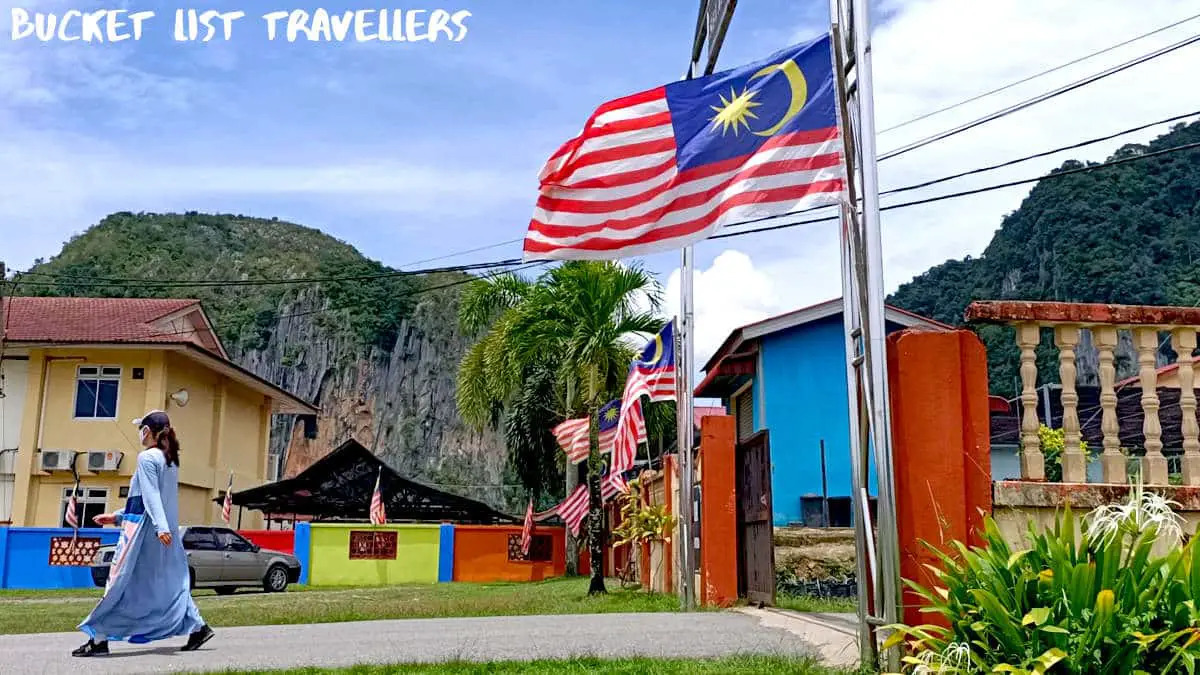Famed as the birthplace of Musang King durian, Gua Musang is a small inland town on Peninsular Malaysia. Located on the Jungle Railway, this town is near the pristine Taman Negara tropical rainforest – one of the oldest rainforests in the world! The area contains many limestone hills and caves, making it a popular destination for cavers and rock climbers. Additionally, the nearby Nenggiri River is a popular location for river rafting. Find out more in this Gua Musang destination guide.
What is Gua Musang Malaysia known for?
Gua Musang is famous as the origin of the eponymous Musang King durian. Notably, this is a prized durian has a unique sweet and bitter flavour profile. However the original tree was cut down to make room for other crops, so there is some debate as to whether Gua Musang is the true birthplace of the Musang King. The small island Rulau Raya also claims to be the birthplace of the Musang King. This island is home to the oldest Musang King durian trees in the world.
Gua Musang is also an important stop along Malaysia’s Jungle Railway, which runs from Gemas all the way to Tumpat.
Why you should visit Gua Musang Malaysia
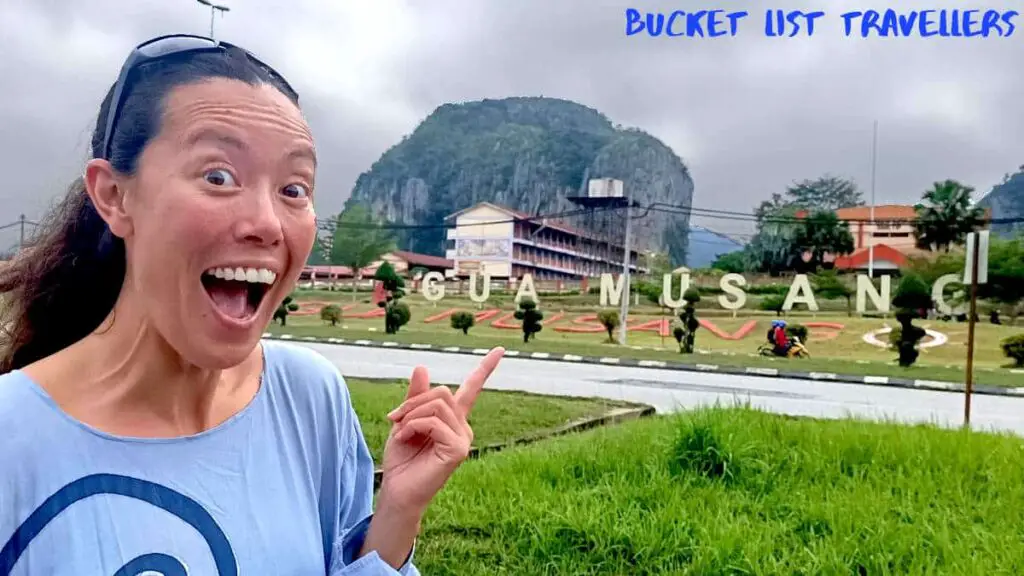
If you’re lucky enough to be in the area for durian season, Gua Musang is a must visit. Durian is known as the king of fruits, and the best variety of durian – Musang King (Mao Shan Wang) – originated in Gua Musang. Apart from feasting on durian, Gua Musang is also a popular outdoor recreation destination. In particular, one of the oldest tropical rainforests in the world, Taman Negara, is not far from Gua Musang. Other outdoor recreation activities in the area include caving, rock climbing and river rafting. The town itself boasts an excellent food scene, scenic parks as well as an impressive mosque that resembles the Haram Mosque in Mecca.
Gua Musang Destination Guide: Know before you go
Basic info about Gua Musang Malaysia
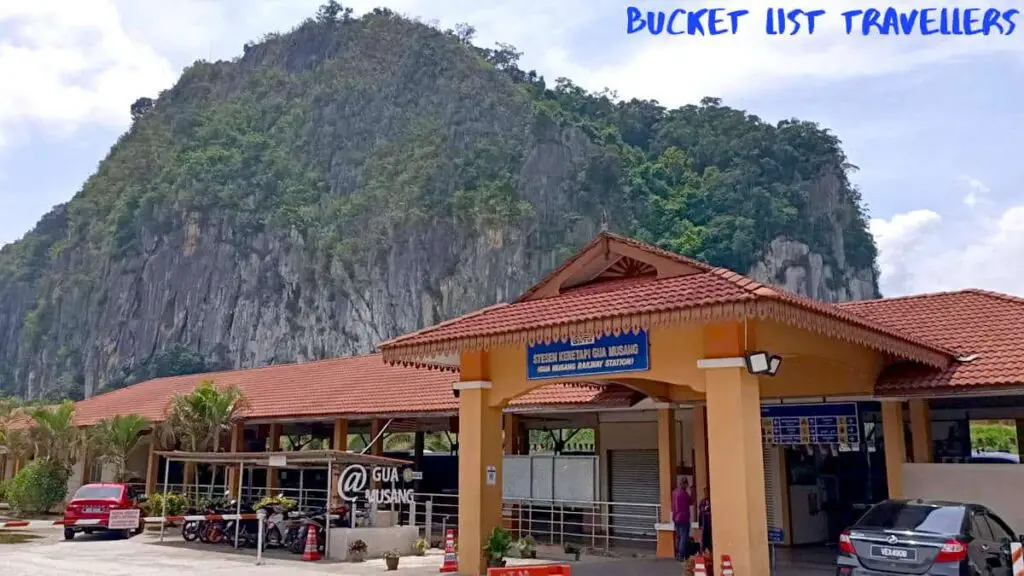
- City name in other scripts – كڬوا موسڠ (Jawi), 话望生 (Chinese), குவா மூசாங் (Tamil), Guo Musae (Kelantanese)
- Language – Malay. There are 10 dialects of Malay used throughout thought the country, with Standard Malay being the unifying language. English is becoming more widely spoken in the country. However not everyone you meet will be able to speak English. Mandarin Chinese, Malaysian Chinese, Tamil, other Indian languages as well as Creole are spoken by the various ethnic groups that live in Malaysia.
- Currency – Malaysian ringgit (MYR). This has been the official currency of Malaysia since 1967. Currency exchanges can be found in most cities and ATMs are available widely throughout the country.
- Population – 19,731 (2017)
- Area – 6,362 km2 (2,456 sq mi) – this is the area for the district of Gua Musang
- District – Gua Musang
- State – Kelantan
- Emergency number – 999
- Police number – 999
Utilities in Gua Musang Malaysia

- Electricity – Malaysia uses Type G power plugs. The country operates on a 240v supply voltage at 50Hz. Power outages are reasonably common in Malaysia.
- Water – the tap water in Malaysia is not generally safe to drink. Whilst tap water is usually treated, pipes may be old. Most locals boil their water or use a water filter just to be safe. We recommend bringing a water purifier such as a Sawyer Mini Water Filter on your trip.
- Toilets – sit-down flushing toilets as well as Asian style squat toilets are common in Malaysia. Toilets generally come equipped with a spray hose (sometimes referred to as a Muslim shower). The spray hose is like a European bidet and is used for cleaning personal areas as an alternative to toilet paper. All of the accommodation we stayed in throughout the country was equipped with the western style sit-down flushing toilets with spray hoses. Toilet paper is also usually provided. Don’t flush your toilet paper – use the bins provided. The use of bathroom slippers is customary and is provided in accommodation and sometimes also in public bathrooms. Public bathrooms often offer both sit-down and squat style toilets. Public toilets are common in Malaysia. The charge is usually around 30-50 sens.
- Telephone country code: +60
Where is Gua Musang Malaysia?
Gua Musang is in the Gua Musang district in the middle of the state of Kelantan Malaysia. This town is on the Galas River (Sungai Galas). It’s also close to the Nenggiri River. Additionally, Gua Musang is on Malaysia’s Jungle Railway (also known as KTM Intercity Eastern Sector). Furthermore, the town is close to the road Federal Route 8, which conntects Kota Bharu with Kuala Lumpur. Gua Musang is at the northern end of Peninsular Malaysia, two hours drive from the border with Thailand.
The closest towns to Gua Musang are Dabong and Kuala Lipis. Gua Musang is 1 hours by car from Dabong and 1.25 hours by car from Kuala Lipis.
How to get to Gua Musang Malaysia
Gua Musang destination guide: Arriving by land
Gua Musang Malaysia intercity land transport

The main transport options for travelling overland to Gua Musang Malaysia are:
- Private vehicle
- Private transport operator
- Train
- Bus
- Bike
Driving to Gua Musang from within Malaysia
If you are driving to Gua Musang from within Malaysia, here are the travel times and distances:
- Dabong, Kelatan – 1 hour 2 minutes (69km, 43miles) without tolls
- Kuala Lipis, Pahang – 1 hour 13 minutes (97km, 60miles) without tolls
- Kota Bharu, Kelatan – 3 hours 6 minutes (189km, 117miles) without tolls
- Kuala Lumpur – 3 hours 38 minutes (252km, 157miles) with tolls or 4 hours 16 minutes (251km, 156miles) without tolls
- Kuala Terengganu, Terengganu – 4 hours 23 minutes (278km, 173miles) without tolls
- Kuantan, Pahang – 4 hours 20 minutes (335km, 208miles) with tolls or 4 hours 34 minutes (307km, 191miles) without tolls
- George Town, Penang – 4 hours 25 minutes (322km, 200miles) with tolls or 6 hours 10 minutes (342km, 213miles) without tolls
- Malacca, Malacca – 5 hours 36 minutes (398km, 247miles) with tolls or 6 hours 10 minutes (395km, 245miles) without tolls
- Johor Bahru, Johor – 8 hours (582km, 362miles) with tolls or 8 hours 46 minutes (556km, 345miles) without tolls
Intercity trains to Gua Musang Malaysia

Gua Musang is a station on the Malaysian Jungle Railway. This line runs from Tumpat (near Kota Bharu) to Gemas.
Intercity buses to Gua Musang Malaysia
A common way to get around Malaysia is by using intercity buses. These are budget friendly and the network is extensive. Intercity bus companies in Malaysia include KKKL Express as well as S&S International.
Popular bus destinations from Gua Musang include:
- Kuala Lipis Malaysia – travel time 2 hours. Tickets start from 9 ringgit one way.
- Kuala Lumpur Malaysia – travel time 5 hours 30 minutes. Tickets start from 25 ringgit one way.
- Kota Bharu Malaysia – travel time 3 hours. Tickets start from 18 ringgit one way.
Gua Musang destination guide: Arriving by air
The closest airport to Gua Musang is Sultan Azlan Shah Airport (IPH). This airport is 103km (64 miles) away.
Other nearby airports include:
- Sultan Mahmud Airport (Airport code TGG). This airport is 138km (86 miles) away.
- Sultan Ismail Petra Airport (Airport code KBR). This airport is 144km (89 miles) away.
- Redang Aiport (Airport code RDN). This airport is 153km (95 miles) away.
The national airline of Malaysia is Malaysia Airlines.
Gua Musang destination guide: Arriving by boat
Gua Musang is on the Galas River. However there are no boats to Gua Musang.
Gua Musang destination guide: How to get around Gua Musang Malaysia
Walking in Gua Musang Malaysia

By far the easiest and cheapest way to get around Gua Musang is to walk. Most of the main attractions in the town are within easy walking distance. However the natural attractions surrounding the town are a bit too far to easily walk to as we’d recommend visiting those attractions by car.
Local buses in Gua Musang Malaysia
There are no local buses in Gua Musang.
Trams in Gua Musang Malaysia
Gua Musang does not have a tram system.
Local trains in Gua Musang Malaysia
Gua Musang does not have a local train line.
Metro trains (subway or underground) in Gua Musang Malaysia
Gua Musang does not have an underground train line.
Vehicle hire in Gua Musang Malaysia

A wide variety of vehicles can be rented in Malaysia. This includes:
- Electric scooters
- Bicycles
- Motorcycles
- Cars
- SUVs
- Boats
In Malaysia they drive on the left side of the road.
Taxis in Gua Musang Malaysia
There is a taxi rank in Gua Musang at the old bus terminal (Terminal Stesen Bas SKMK). At the taxi rank there is a noticeboard displaying the phone numbers of taxi drivers in the area. There is also a list of taxi fares to various destinations – for example, Gua Musang to Ipoh is 350 ringgit (as at 2022).
Taxis are common in Malaysia. Fares are regulated and are usually metered. However taxi drivers in Malaysia do not have the best reputation, which is why alternative services like Grab are very popular.
In general your fare will include the following costs:
- The pickup fee or minimum fee – this is charged as soon as you get into the vehicle.
- Airport surcharge – this is an additional fixed fee for travelling to an airport.
- Price per kilometre – the rate is double between midnight and 6am.
- Price per hour – this is a price that gets charged when the taxi is stuck in heavy traffic.
- Surcharge for more than 2 adult passengers – this is an additional fixed fee.
- Surcharge for using the luggage compartment – this is an additional fixed fee.
- Surcharge for booking by phone – this is an additional fixed fee.
- Road toll charges
Check that the meter gets switched on at the start of your journey at the right rate. We also recommend bringing enough change in cash as drivers generally only accept cash and may not have change.
Alternatively, if booking in advance the fare may be a fixed price that is agreed on before the trip. Some taxis also operate on a pre-paid coupon system where the coupon is purchased from a counter at the airport.
It is not necessary or expected to tip taxi drivers in Malaysia.
Ride-share services in Gua Musang Malaysia
Gua Musang is a small town, so the major ride-share services do not operate here. However you may be able to pay a local to drive you around.
Grab is the main app based ride-hailing service in Malaysia. Other ride-share services in Malaysia include MyCar, MULA, DACSEE, EzCar, inDriver as well as the women only service Riding Pink. Uber no longers operates in Malaysia after Grab acquired all of its Southeast Asia assets. Lyft services only Kuala Lumpur in Malaysia via its Grab partnership.
Gua Musang destination guide: Is Gua Musang Malaysia worth visiting?
Gua Musang is a great stop along Malaysia’s jungle railway. It is surrounded by stunning limestone landscape with plenty of outdoor activities to enjoy. Moreover, many people make the trip to Gua Musang to indulge in delicious top quality durian. It is well worth a visit when you’re in the area.
Gua Musang destination guide: How long to spend in Gua Musang Malaysia

Gua Musang is a scenic Malaysian town which is famed for its durian. The town has a scale replica of the mosque from Mecca, and this attracts many pilgrims. Additionally, Gua Musang is surrounded by beautiful limestone hills and caves, a tropical rainforest as well as the Nenggiri River. Located on the Jungle Railway, it is perfect for a short stop when travelling through Malaysia by train. We spent 2 nights in Gua Musang and particularly admiring the scenery and exploring the local area.
Gua Musang destination guide: What to do in Gua Musang Malaysia
Gua Musang is a scenic Malaysian town with a number of interesting activities on offer. It has a range of great free activities as well as paid activities.
Gua Musang destination guide: Free things to do in Gua Musang Malaysia

There are enough free activities in Gua Musang Malaysia to keep you entertained for a day or two:
- Water and Moon Temple (水月宫 Shuǐ Yuè Gōng)
- Gua Musang Caves
- Taman Tasik Gua Musang
- 紫霞洞 (Zi Xia Cave Temple)
- Ethnobotany Park
- Rekreasi Rimba Wangi Sungai Ketil
- Masjid Razaleigh Mosque
Gua Musang destination guide: Paid activities in Gua Musang Malaysia
A number of attractions in Gua Musang Malaysia charge an entry fee:
- Taman Negara National Park – entry fee 1 ringgit for adults plus 6 ringgit per camera/video recorder (as at 2023).
- Bukit Gua Musang
- Muse Ecopark
- River rafting on the Nenggiri River
- Rock climbing
Weather in Gua Musang Malaysia

The climate for Gua Musang is classified as tropical, with relatively uniform hot temperatures and also high humidity throughout the year. The hottest month is May with an average temperature range of 23°C to 32°C (73°F to 90°F) and coldest month December with an average temperature between 21°C-30°C (70°F to 87°F). Gua Musang is affected by the Northeast Monsoon from November to early March, which is typically the rainiest monsoon season. During this time Gua Musang is prone to flooding. Conversely, the Southwest Monsoon from June to September does not impact Gua Musang. The intermonsoonal period between the two monsoons is from March through June and is the hottest and most uncomfortable weather of the year.
Best time to visit Gua Musang Malaysia
We recommend visiting Gua Musang during durian season, which aligns to the Southwest Monsoon season in Malaysia. While the exact timing for durian season varies from year to year, peak harvest is generally from June to August. However if you are visiting Gua Musang for outdoor activities not related to durians the best weather in Gua Musang is from late December to mid March.
Internet and mobile phones in Malaysia
Major internet and phone companies in Malaysia – Celcom, Digi, Hotlink (Maxis), U Mobile, UniFi Mobile, Tune Talk, Yes, XOX Mobile / ONEXOX, redONE, Yoodo, Telekom Malaysia and Time dotCom.
5G has been in Malaysia since December 2021. 2G will not be be switched off in Malaysia. 3G is was switched off in March 2022.
Malaysia is ranked 46th fastest in the world for mobile internet speeds and 38th fastest for fixed broadband. For Fixed Broadband the average download speed is 94mbps and upload is 51mbps (as at April 2023).
Cell phone SIM cards can be bought in a numbers of places throughout Malaysia. These include phone stores, in shopping malls, at bus stations as well as at airports. Some form of ID, such as a passport, is required in order to purchase a SIM card in Malaysia.
How much to budget for Gua Musang Malaysia?
Is Gua Musang Malaysia expensive?
Gua Musang Malaysia is an affordable Malaysia travel destination. Accommodation prices are quite reasonable and there are no luxury hotels in town. Food and activity costs are also very affordable.
Gua Musang destination guide: Daily spend for a couple travelling in Gua Musang Malaysia

As a rough guide, we recommend the following budgets for a couple:
- Low-budget daily spend – 150 ringgit per day for a couple will get you hostel accommodation, meals from bakeries and markets, local transport and free or cheap activities such as visiting temples, caves and parks
- Mid-range daily spend – 300 ringgit per day for a couple will get you mid-range accommodation, local transport, restaurant meals and a few paid activities
- Luxury spend – Gua Musang is not a luxury destination
Gua Musang destination guide: Accommodation in Gua Musang Malaysia
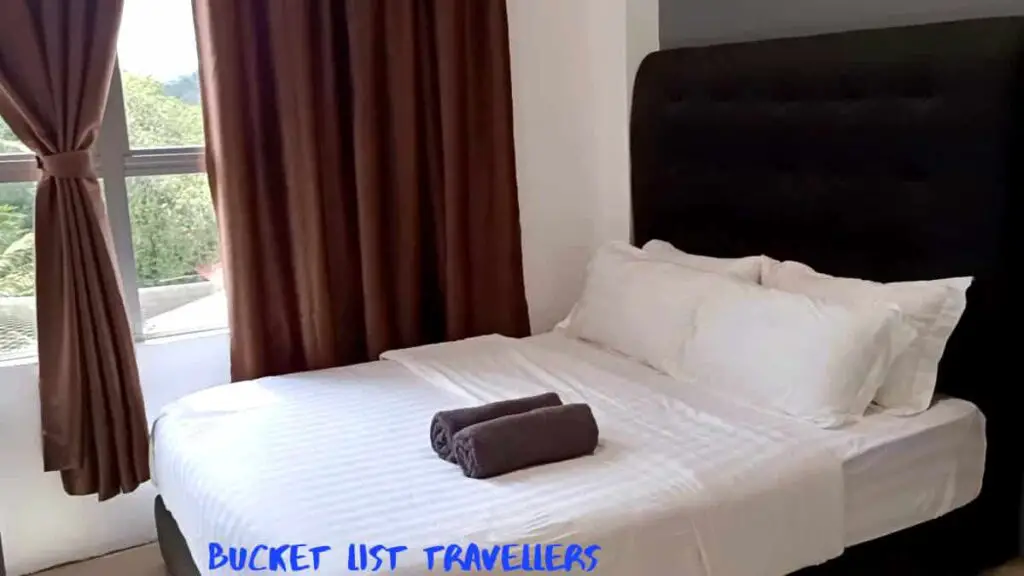
There is a good range of accommodation to suit most budgets in Gua Musang Malaysia. Airbnb operates in Malaysia, and there are a few Airbnb properties in Gua Musang. Wifi is not always provided for Airbnb properties in Malaysia, so we recommend checking if it is included in the listing. One thing to keep in mind with hotels in Malaysia is that smoking in hotel rooms is often permitted.
Where to stay in Gua Musang Malaysia
We recommend the following accommodation in Gua Musang Malaysia:
- Best budget hotel in Gua Musang Malaysia – we stayed at Phoenix Hotel in Gua Musang. It’s conveniently located in the centre of town, a short walk from the train station. We didn’t think the rooms looked as good as the photos, but for a short stay it provides reasonable value.
- Best mid-range accommodation in Gua Musang Malaysia – Durian Hill Villa is the best 4 star property in Gua Musang. Located on the outskirts of town, this property has spacious rooms and is clean and comfortable.
How much is accommodation in Gua Musang Malaysia?
For short-term accommodation, a general price per night is as follows:
- Budget accommodation – there is no dorm accommodation in Gua Musang. The cheapest accommodation is 43 ringgit for a private room.
- Mid-range accommodation – 75-160 ringgit for a private room.
- Luxury accommodation – there is no luxury accommodation in Gua Musang.
- Rental property – 260-350 ringgit a night for a fully furnished 3-4 bedroom home.
Tourist tax on accommodation in Malaysia

From 1 January 2023 there is a tourist tax of 10 ringgit per accommodation per night in Malaysia. This tax is collected by the property. Permanent residents and Malaysian nationals are exempt from the tax. Furthermore the tourist tax does not apply to homestays and kampung stays registered with the Ministry of Tourism.
Gua Musang destination guide: Food in Gua Musang Malaysia
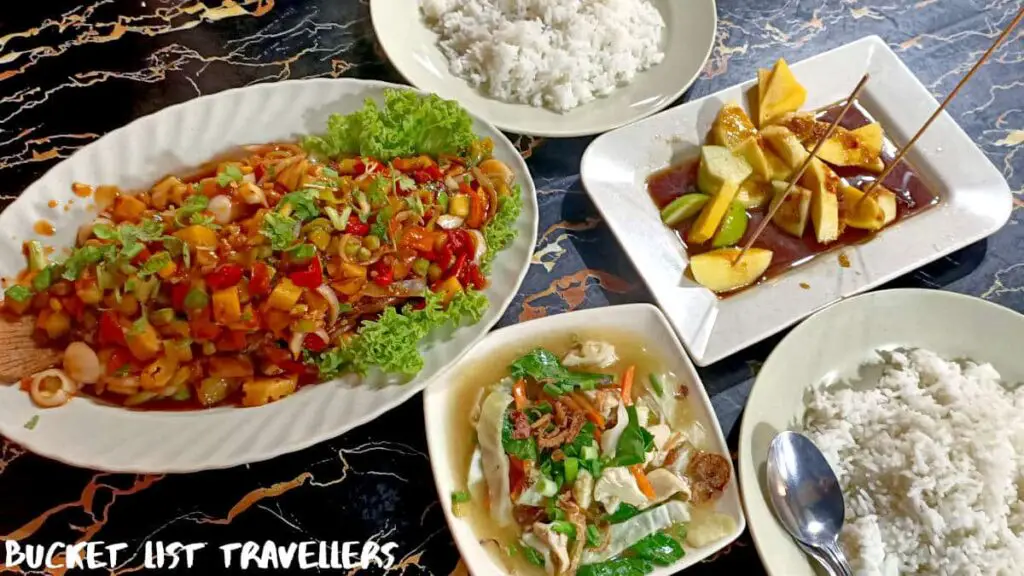
Being close to the border with Thailand, Thai food is very popular in Gua Musang. The area is also home to a number of regional dishes. When in Gua Musang you must also try the local Musang King durian, the best in all of Malaysia!
How much does food cost in Gua Musang Malaysia?

Our price guide for your food budget in Gua Musang Malaysia is as follows (prices as at 2022):
- Restaurant meal – 30-60 ringgit for a main dish
- Night market or hawker market food – 5-15 ringgit for a dish
- Ais kachang – 4-6 ringgit
- Coffee – 1.50-2.50 ringgit
Regional dishes in Gua Musang Malaysia

- Musang King durian
- River fish
- Mutton soup
Cheap Eats in Gua Musang Malaysia

- Bakeries are a great place to get cheap and delicious food.
- Hawker centres in Malaysia are ubiquitous and have excellent budget friendly food. The variety of stalls available means that you have a good range of options to choose from.
- Night markets in Malaysia are another of our go to places for affordable and tasty food. There’s also usually stalls selling items like clothes, toys and shoes in addition to the food stalls.
- Street food is also a very common cheap eat option in Malaysia. You can often find street food around transport hubs as well as scattered in various places around the city.
Gua Musang Malaysia culture
Weekends in Kelantan Malaysia

Which days are weekdays and weekend days vary in Malaysia depending on the state you’re in. In the state of Kelantan weekdays are Sunday to Thursday and weekends are Friday and Saturday. Keep this in mind as weekends can affect prices and availability (particularly for accommodation). Additionally weekends may impact opening hours as well as how crowded attractions are.
Kelantan public holidays

Malaysia has one of the highest number of public holidays in the world. In total, there are between 18 and 20 public holidays observed in each state. This includes national holidays as well as state based holidays. Public holidays for the state of Kelantan are as follows:
- Chinese New Year’s Day – 1st day of 1st lunar month, in January or February
- Chinese New Year Holiday – 2nd day of 1st lunar month, in January or February
- Nuzul Al-Quran Day – 17th day of Ramadan
- Labour Day – 1 May
- Wesak Day (Buddha’s birthday) – May or June, date varies
- Hari Raya Aidilfitri – the last day of Ramadan, date varies
- Hari Raya Aidilfitri Holiday – day after the last day of Ramadan, date varies
- Yang di-Pertuan Agong’s Birthday (King’s Birthday) – 1st Monday in June
- Hari Raya Haji (Feast of the Sacrifice) – date varies
- Hari Raya Haji Holiday (Feast of the Sacrifice) – date varies
- Awal Muharram (Islamic New Year) – date varies
- Merdeka Day (National Day, Independence Day) – 31 August
- Malaysia Day – 16 September
- Maulidur Rasul (Prophet Muhammad’s Birthday) – 12th day of the 3rd month of the Islamic calendar
- Deepavali – date varies, October or November
- Sultan of Kelantan’s Birthday – 11 November
- Sultan of Kelantan’s Birthday Holiday – 12 November
- Christmas Day – 25 December
National symbols of Malaysia
- Malaysia flag – 14 alternating red and white stripes with a blue canton with a yellow crescent and 14 pointed star. The Malaysian flag is called the Stripes of Glory.
- Malaysia coat of arms – two tigers supporting a shield with a yellow crescent and a 14 pointed star on top and a yellow banner with words that translate to “Unity is strength” written in both romanised Malay and Jawi at the bottom.
- National flower – hibiscus
- National bird – rhinoceros hornbill
- Malaysia national animal – the Malayan tiger
Malaysia pastimes

- National dish – nasi lemak
- Popular drinks – teh tarik, Ipoh white coffee, milo ais, sirup bandang
- National sport – sepak takraw
- Religion – 64% Islam, 19% Buddhist, 9% Christian, 6% Hindu (as at 2020)
Is Gua Musang Malaysia Safe?
Malaysia travel guide: Safety in Malaysia

We have spent around 4 months travelling extensively through Malaysia over two separate trips. In our experience the country is extremely safe. Malaysia ranks 18th safest country on the Global Peace Index (as at 2022). As with any country, there are good areas and bad areas. Watch out for pickpockets and bag snatching particularly at crowded tourist attractions. In particular, when eating out don’t leave your bag, phone or wallet on the table or next to you where someone can quickly grab it and run away. Instead keep your belongings physically attached to you at all times. Make sure no-one is watching whenever you are entering pin codes and never lose sight of your credit card when making a purchase.
General safety considerations in Malaysia
Other general safety considerations for travel in Malaysia:
- Drinking water – tap water in Malaysia is not generally safe to drink. Tap water is usually treated, but pipes may be old. Therefore most locals boil their water or use a water filter. We recommend bringing a water purifier such as a Sawyer Mini Water Filter on your trip.
- Mosquitoes – mosquito borne illnesses are a significant risk in Malaysia, particularly dengue, Zika and chikungunya. Malaysia is in the pre-elimination phase of malaria. While malaria is a greater risk in Malaysian Borneo, there have also been cases on the Malaysian peninsula. Take precautions to avoid mosquito bites.
- Altitude sickness – Malaysia has areas of high altitude and therefore altitude sickness risk. If you visit high altitude areas in Malaysia, allow sufficient time to acclimatise. If you experience signs of altitude sickness, including headache, nausea or vomiting, dizziness, tiredness, loss of appetite or shortness of breath, get help immediately.
- Road safety – Road accidents are a significant risk in Malaysia. While road conditions are generally very good, traffic is often heavy. Furthermore drivers tend to speed up rather than slowing down for amber lights. Roads in Malaysia are also not typically built with pedestrians in mind.
- Water safety – take care when swimming as currents and waves may be stronger than you expect.
- Earthquakes – Malaysia experiences both regional and local earthquake activity. In an earthquake, stay away from glass, windows, outside doors and walls and anything that could fall. If inside, get under a table, desk or solid furniture and hang onto it. Cover your head and torso to protect from falling objects. If outside, stay outside and go to an open area away from buildings.
- Sun safety – Exposure to the sun can have adverse short-term and long-term effects on the skin, eyes and immune system. Sun protection such as sunscreen, a hat and sunglasses is very important to ensure you don’t get burnt.
- Dogs – rabies from rabid dog bites is a risk in Malaysia. For more on dog safety while travelling, check out this video.
As with any destination, take all of your normal safety precautions.
Malaysia Blogs
You can find our Malaysia travel blogs below.

Putrajaya Destination Guide: Everything You Need to Know (2024)

Cyberjaya Destination Guide: Everything You Need to Know (2024)

Kuala Lumpur Destination Guide: Everything You Need to Know (2024)

Raub Destination Guide: Everything You Need to Know (2024)
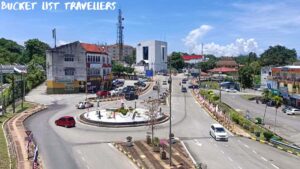
Kuala Lipis Destination Guide: Everything You Need to Know (2024)

Gua Musang Destination Guide (2024): What You Need to Know

Dabong Destination Guide (2024): What You Need to Know

Kuala Krai Destination Guide (2024): What You Need to Know

Kota Bharu Destination Guide (2024): What You Need to Know
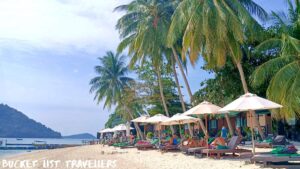
Perhentian Islands Destination Guide (2024): What You Need to Know

Kuala Besut Destination Guide (2024): What You Need to Know

Redang Island Destination Guide (2024): What You Need to Know

Kuala Terengganu Destination Guide (2024): What You Need to Know

Kuantan Destination Guide (2024): What You Need to Know

Pekan Destination Guide (2024): What You Need to Know
Affiliate Links
This website contains affiliate links, which means we may earn a commission on any purchases at no additional cost to you. Your support helps us continue our travels and make more travel blogs and travel videos, thank you!
